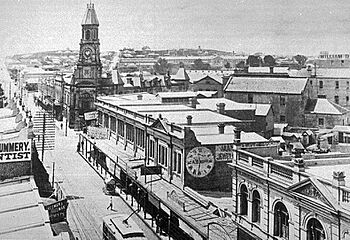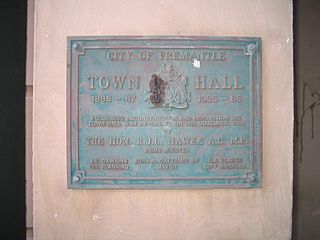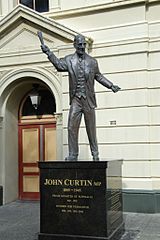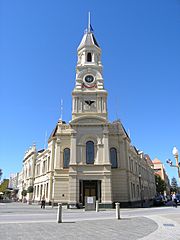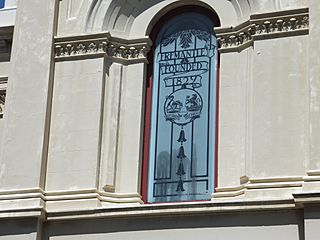Fremantle Town Hall facts for kids
Quick facts for kids Fremantle Town Hall |
|
|---|---|

The building remains almost unchanged since construction
|
|
| General information | |
| Type | Town hall |
| Location | Fremantle, Western Australia |
| Coordinates | Lua error in Module:Coordinates at line 614: attempt to index field 'wikibase' (a nil value). |
| Type | State Registered Place |
| Designated | 9 November 1993 |
| Reference no. | 1015 |
The Fremantle Town Hall is an important building in the port city of Fremantle, Western Australia. You can find it at the corner of High, William, and Adelaide Streets. It officially opened on 22 June 1887. This date was special because it was also when Queen Victoria's Jubilee was celebrated. The mayor, Daniel Keen Congdon, and the state governor, Frederick Broome, named it the Town and Jubilee Hall.
Contents
Planning the Town Hall
Early Ideas for a New Building
Back on 7 June 1876, a local council member named E.H. Higham suggested a new town hall. He thought the council should ask the Colonial Secretary for a special piece of government land. This land was at the corner of South Terrace and Essex Street.
The state governor, William Robinson, agreed to let them use the site. He even offered help from workers and free building plans from the government engineer. The governor also promised to ask the Legislative Council for money to help build it. However, the plans made by the government engineer are no longer around today.
Finding the Right Location
On 11 July, a meeting was held to talk about how much money was needed. W.E. Marmion suggested buying a more central spot on High Street. His idea was not chosen at that time. Because they couldn't get enough money, the building plans did not move forward.
Later in 1876, the council bought the more central High Street site. This happened after the Church of England decided to move their first church. They sold part of their land to the council. This sale helped fund their new church and gave the council a good triangular piece of land for the new town hall.
Designing the Building
In April 1881, the head of the Council brought up the town hall idea again. He suggested a building that would cost no more than £8000. This amount is like A$Error when using : |start_year=1,881 (parameter 3) is lower than the earliest available year (1,901) in index "AU". million today. Attempts to raise money locally didn't work. The first architect's plans were not chosen. Instead, Melbourne architects John Grainger and Charles D'Ebro were picked. They also designed the National Bank in Fremantle.
Building the Town Hall
Starting Construction
In 1884, builders were asked to submit bids for the project. However, all the bids were too expensive. The design was changed to make it cheaper. When bids were asked for again, only one builder, Edward V. Keane, offered a price. He gave four different price options, from £19,832 down to £12,400. The council decided to work with him. At first, they only planned to build the main hall, a supper room, kitchen, and entrance area.
Another meeting with local residents was held. People strongly encouraged the council to build the entire building as planned.
The Grand Opening
Construction began on 28 May 1885. It was supposed to be finished by 28 November 1886. The first stone was laid on 10 September 1885 by Governor Frederick Napier Broome. The town hall finally opened on 22 June 1887. This was seven months later than planned, but it allowed the opening to happen at the same time as Queen Victoria's Jubilee celebration. The opening day included sports and a big dance in the evening. Children in government schools in Perth and Fremantle even got an extra week of holiday!
-
John Curtin statue at Fremantle Town Hall
Architecture and Design
Local architects Griffiths and Considine, who worked with the Melbourne designers Grainger and D'Ebro, described the building's look. They said it has a "Victorian free style" that uses classical architecture ideas.
Classical Elements and Unique Towers
The building's outside walls use many classical features. These include triangular shapes above windows (pediments), rough-looking stone on the ground floor, tall columns (Corinthian pilasters), and fancy window frames. It also has decorative carvings and patterns. All these details are made to look like stone. At the very top, the classical style changes. It features many towers, which are not usually found in classical buildings. This mix of styles makes the Fremantle Town Hall very unique!



